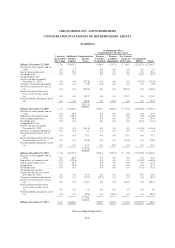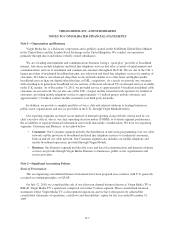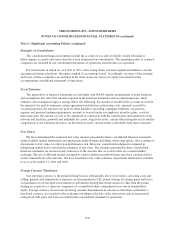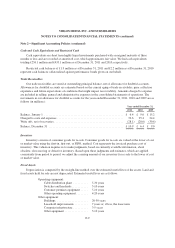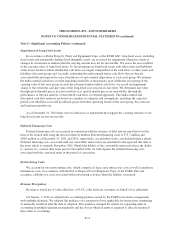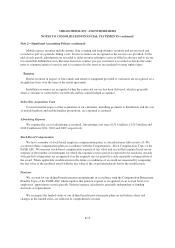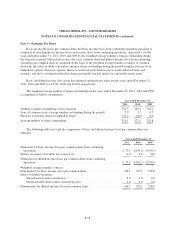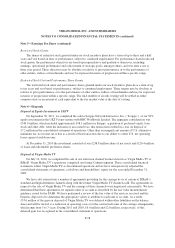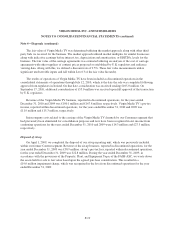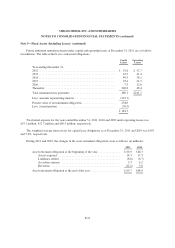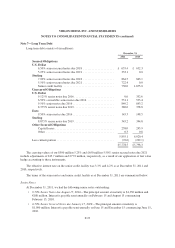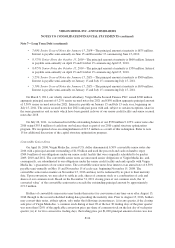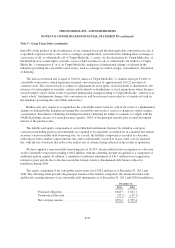Virgin Media 2011 Annual Report Download - page 104
Download and view the complete annual report
Please find page 104 of the 2011 Virgin Media annual report below. You can navigate through the pages in the report by either clicking on the pages listed below, or by using the keyword search tool below to find specific information within the annual report.VIRGIN MEDIA INC. AND SUBSIDIARIES
NOTES TO CONSOLIDATED FINANCIAL STATEMENTS (continued)
Note 2—Significant Accounting Policies (continued)
Equity-linked Instruments
We determine the accounting treatment of equity-linked instruments according to the Distinguishing
Liabilities from Equity and Derivatives and Hedging Topics of the FASB ASC. This involves assessing whether
the instrument falls within the scope of the first topic and should be classified as an asset, liability or as equity. If
the guidance in the first topic is not applicable, we evaluate the instrument according to the second topic to
determine whether it is indexed to our stock and if necessary, whether it would be classified in equity.
Operating Leases
Our leasing activities are principally related to administrative facilities, network related facilities, retail
facilities and operating equipment. These leases generally provide us with renewal options. Certain leases contain
fluctuating or escalating payments and rent holiday periods. The related rent expense is recorded on a straight
line basis over the lease term.
Contingent rent is not a material component of our total rent expense.
Income Taxes
We provide for income taxes in accordance with the Income Taxes Topic of the FASB ASC. Judgment is
required in determining our provision for income taxes, deferred tax assets and liabilities and the extent to which
valuation allowances are necessary to reduce our deferred tax assets. We recognize valuation allowances if it is
not more likely than not that sufficient taxable income will be available in the future against which the temporary
differences and unused tax losses can be utilized. We have considered future taxable income and tax planning
strategies in assessing whether deferred tax assets should be recognized.
Recent Accounting Pronouncements
In September 2011, the FASB issued guidance permitting companies to first assess qualitative factors as a
basis for determining whether it is necessary to perform the two-step goodwill impairment test. The guidance is
effective for goodwill impairment tests performed for fiscal years beginning after December 15, 2011; however,
early adoption is permitted. We adopted this guidance effective October 1, 2011 and applied it to the
performance of our annual goodwill impairment test for both the consumer and business reporting units.
On January 1, 2011 we adopted new accounting guidance issued by the FASB for revenue arrangements
with multiple-elements. We adopted this guidance on a prospective basis applicable for transactions originating
or materially modified after the date of adoption. This guidance changed the criteria for separating units of
accounting in multiple-element arrangements and the way in which an entity is required to allocate revenue to
these units of accounting. The adoption of this guidance has not had a material impact on our consolidated
financial statements for the year ended December 31, 2011. This is principally due to the fact that although prior
to the adoption of this guidance we were unable to meet the criteria to separate the units of accounting for our
residential customer arrangements, the Cable Television Topic of the FASB ASC required us to recognize initial
hookup revenues to the extent we had incurred direct selling costs. The impact of the adoption of this guidance
may be material in future years if we make material changes to product or service offerings, pricing structures, or
the components of bundled arrangements, or if we enter into material new arrangements in our Business segment.
F-15



